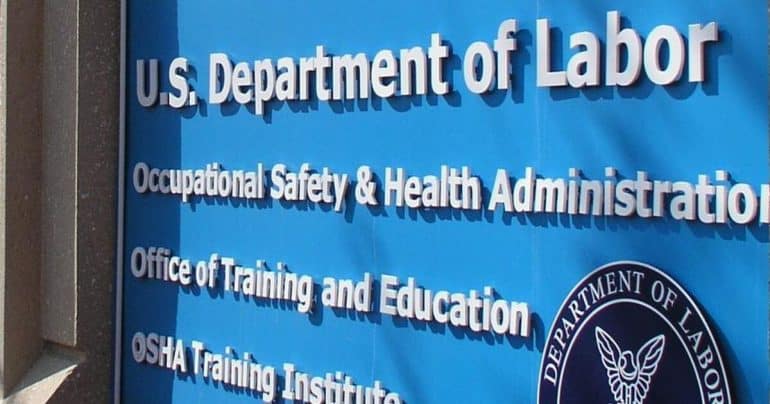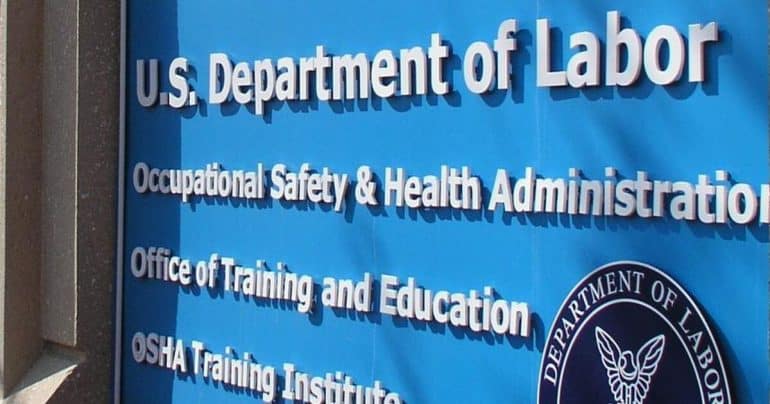OSHA’s role in the mass masking of the American workforce has mostly flown under the public’s radar. However, its expected role in the mass jabbing of the workforce is in the spotlight due to its new Emergency Temporary Standard (ETS). The ETS requires employers with one hundred employees or more to mandate their employees to either show proof of COVID-19 vaccination or submit to weekly testing and wear a face covering (unless the employees work from home or exclusively outdoors).
As discussed below, the ETS will not improve the safety of American workers and will unnecessarily impose health risks upon them.
However, before delving into those issues, this article will first address the myth that employers have widely “decided” of their own volition to require masks and COVID-19 vaccines and that these have been “private” decisions.
1. Employers’ decisions to require masks and COVID-19 vaccines have been a construct of the state, even aside from direct state requirements.
Public health agencies have put forth a fraudulent narrative concerning COVID-19 by: exaggerating the risks posed by COVID-19 and the benefits of COVID-19 vaccines and downplaying the vaccines’ risks; exaggerating the benefits of masking and downplaying the risks of masking; and steering the public away from beneficial treatments. The spurious nature of much of the “official” COVID-19 narrative has been well documented by Children’s Health Defense, Informed Consent Action Network, The HighWire, Dr. Joseph Mercola and Jeremy R. Hammond and will not be repeated in this article.
The “official” COVID-19 narrative (of grave danger posed by COVID-19; COVID-19 vaccines as safe and necessary; and masks as necessary per the CDC’s recommendation du jour) has permeated the American psyche via an extensive campaign that has included: messages flashing on highway signs; announcements continually repeated over intercoms in public places; non-stop public service announcements; and a daily barrage of pieces from the state’s cronies in the corporate press. Given the campaign, it’s absurd to suggest that employers would have required masks and COVID-19 vaccines in the absence of the state.
Employers who are unconvinced by the “official” COVID-19 narrative must nonetheless operate in a society in which it is widely accepted. Also, the state has played a role in suppressing scientific information that conflicts with the narrative, thereby preventing employers from learning of it and considering it in crafting their policies.
Of course, even prior to the issuance of the ETS, the state did more with regard to COVID-19 than just propagandize the public about it. Lockdown and mask orders are likely the first COVID-19 state actions that come to mind for most. However, many employers also faced OSHA complaints, inspections, and citations for not requiring employees to mask up in accordance with CDC guidance and this interfered with their discretion to make their own mask decisions.
Now that OSHA has issued the ETS, employers will also be subject to these OSHA measures for failure to follow the vaccine requirements. One difference will be that OSHA has generally relied upon the General Duty Clause as the basis for its mask activity, rather than a specific standard, and will rely on the ETS as its justification for its vaccine-related activity.
2. Just as the CDC has morphed into an agent of Big Pharma, nearly all governmental agencies, including OSHA, have morphed into agents of the CDC.
It’s often argued that the CDC has been “captured” by the industry it’s tasked with regulating, Big Pharma. However, another kind of “capture” is occurring—the capture of governmental agencies, at all levels, by the CDC, or those pulling the strings of the CDC. It’s as though nearly every governmental institution’s new motto is, “What the CDC says.”
OSHA’s recent, hasty reversal of its guidance regarding whether adverse reactions to employer mandated COVID-19 vaccines must be recorded on OSHA logs reeks of the latter type of capture and of an agency carrying water for the CDC.
On April 20, 2021, OSHA issued guidance essentially stating that if employers required employees to be vaccinated for COVID-19 then any adverse reactions to the vaccines must be recorded on the OSHA logs. It was arguably unnecessary for OSHA to issue this guidance because it was consistent with the general rule that work-related injuries and illnesses must be recorded. Therefore, presumably, someone at OSHA with power wanted it well understood by employers that adverse reactions to the vaccines they required would be recorded and tracked.
However, whoever caused that guidance to be issued apparently lacked the juice to make it stick. It was reversed about a month later, on May 21, 2021, when OSHA replaced it with guidance stating that “OSHA does not wish to have any appearance of discouraging workers from receiving COVID-19 vaccination, and also does not wish to disincentivize employers’ vaccination efforts” and that, “[a]s a result, OSHA will not enforce 29 CFR 1904’s recording requirements to require any employers to record worker side effects from COVID-19 vaccination through May 2022” and further that it would “reevaluate the agency’s position at that time to determine the best course of action moving forward.”
Between April 20, 2021 and May 21, 2021, when the initial guidance was issued and then reversed, there was no material change in the risks posed by COVID-19 which necessitated the reversal. In fact, during that period, the 7-Day cumulative incidence rate of COVID-19 cases, and of deaths, was falling, and reports of adverse reactions to COVID-19 vaccines were rapidly accumulating in VAERS, as they still are.
To recap, as it now stands, employers must record on OSHA logs any purported work-related cases of COVID-19, as well as any other work-related illnesses or injuries, except for those which appear to be related to employer required COVID-19 vaccines which, by the CDC’s own admission, do not prevent the transmission of COVID-19.
It should be evident to anyone with minimal reasoning skills that the recording requirement reversal was antithetical to safety and was driven by a desire to conceal evidence of adverse reactions to COVID-19 vaccines.
3. OSHA is engaging in hypocrisy by forcing vaccines that pose clotting and cardiovascular risks upon employees after years of hounding employers about preventing strokes within the context of heat illness.
In the years leading up to COVID-19, OSHA particularly focused on preventing heat related illness in the workplace, including heat stroke. It issued many citations related to this, including a set issued to the USPS on the grounds that its practices pertaining to mail carriers delivering in the heat violated the General Duty Clause (i.e., presented a hazard causing or likely to cause death or serious physical harm). The citations issued to the USPS were litigated, complete with testimony from the two agencies’ dueling scientific experts, and initial decisions were issued in favor of the USPS, which are under appeal.
First, the OSHA v. USPS litigation demonstrates that federal agencies can disagree over matters of science, and that one agency can challenge another agency’s scientific conclusions. Agencies blindly deferring to the CDC with regard to COVID-19 should remember this.
Second, it’s stunning that OSHA has the audacity to compel employees to receive COVID-19 vaccines, which are increasingly being linked to clotting and cardiovascular risks (among others), after years of chastising and citing employers for having practices that allegedly cause a risk of heat stroke. The clotting and cardiovascular issues being associated with the vaccines are on par with heat stroke in terms of seriousness.
Apparently the risk of workers experiencing strokes is acceptable if caused by a Big Pharma product, but not acceptable if caused by the sun.
Or perhaps OSHA is not paying attention to the reports of adverse reactions to COVID-19 vaccines. VAERS data released by the CDC reflects a total of 798,636 reports of adverse events from all age groups following COVID-19 vaccines, including 16,766 deaths and 117,399 serious injuries, between December 14, 2020 and October 8, 2021. Further, VAERS is capturing only a small fraction of actual adverse reactions to COVID-19 vaccines. An HHS-funded study by Harvard Medical School tracked reporting to VAERS over a three-year period at Harvard Pilgrim Health Care and concluded in 2011 that “fewer than 1% of vaccine adverse events are reported.”
It’s helpful to remember when considering the issue of COVID-19 and the ETS that the average American worker retires in his or her mid-sixties, and that the vast majority of workers are younger than 69, with an extremely small risk of death from COVID-19. According to information from Stanford physician, epidemiologist and statistician John Ioannidis, all age groups have COVID-19 infection survival rates of well over 99% until reaching their seventies.
4. Businesses should consider forming mutual aid societies as a means of thwarting the Biden Administration’s OSHA plan.
Where the ETS is concerned, the Biden Administration is doing one of the things that the state does best, causing dissention among groups. It’s pitting employers and employees against each other.
OSHA’s penalties are already steep and the Biden Administration is attempting to dramatically increase them. If passed, the Build Back Better Act would increase penalties for serious violations to $70,000 and penalties for willful and repeat violations to $700,000.
The ETS puts employers in the position of having to choose between potentially being wiped out by OSHA penalties or imposing vaccines of unproven safety and necessity upon employees. (Further, there is evidence that the vaccines may actually increase the risks posed by COVID-19. One recent study found that those who were fully vaccinated were more likely than the unvaccinated to be infected with problematic variants of COVID-19. This finding is consistent with warnings from by renowned scientists Geert Vanden Bossche, Ph.D., DVM, and Robert W. Malone, M.D., M.S.) The ETS also puts employees in the position of having to choose between participating in walkouts or sickouts, which will operationally decimate their employers, or taking a vaccine that may cause them serious harm or death.
Fortunately, OSHA currently lacks the personnel to widely enforce the ETS. Doing so will require inspecting a vast number of businesses and following up by issuing citations to them and litigating the citations. OSHA will have no choice but to focus on a few businesses and make examples out of them, in order to keep the others in line. This is a common tactic of repressive regimes.
OSHA’s enforcement problem will, of course, be of little comfort to the few businesses that are issued citations. Maybe the ETS will be struck down through legal challenges. However, business owners may not want to wait for a reasonable judge to come along and rescue them. They may wish to consider forming mutual aid societies, whereby members agree to assist one another in the payment of the penalty should any member be issued a citation for violating the ETS.
5. Employees who believe that their health and/or lives are being put at risk by a workplace COVID-19 vaccine mandate may wish to file complaints with OSHA notifying it of this.
OSHA exists to protect American workers and it has a duty to do so. Workers should demand that OSHA actually execute that duty. They can do so, in part, by filing complaints with OSHA notifying it of the risks posed to them by employer mandated COVID-19 vaccines. The complaints should include a copy of the scientific evidence demonstrating those risks, or links thereto. OSHA’s complaint form is available on its website.
When the dust settles on the COVID-19 vaccine mandate train wreck, OSHA personnel shouldn’t be allowed to get off scot-free for their role in it. Filing OSHA complaints with proof of the dangers of the vaccines will assist in this regard, as it will make it harder for them to claim plausible deniability.


